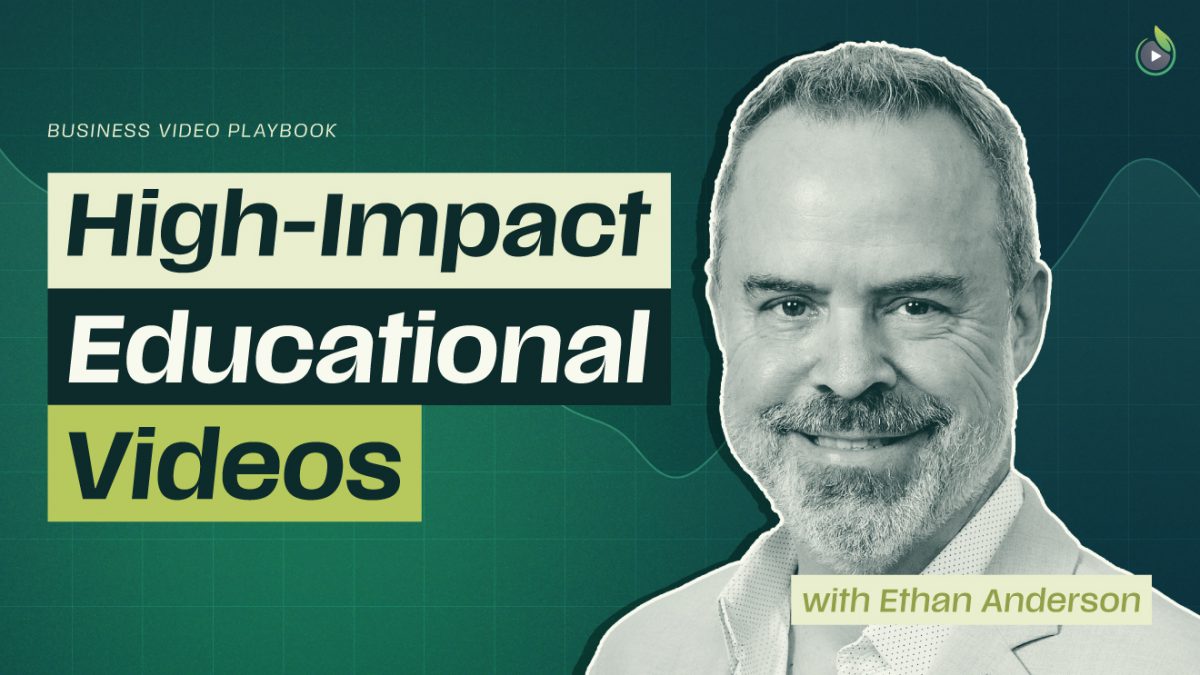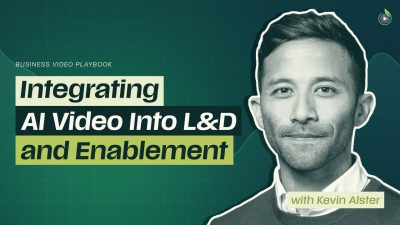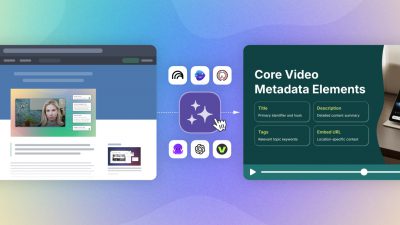What if you could uncover a formula to double the engagement of your video-based learning initiative? Then, picture using this formula to help struggling students not only catch up but leap ahead, fully prepared for long-term success.
These outcomes are routine for Ethan Anderson, Director of Product Management for NOLA Education’s Star Academy. In this short interview, he explains how Star Academy leverages research, video, and multimodal learning to increase engagement and drive academic and social success.
His insights are invaluable for developing video-based learning, professional training videos, and thought leadership content. By watching this interview, you’ll learn how to:
- Use AI for creating training videos
- Optimize video length for retention
- Incorporate video into multimodal learning
- Leverage research to achieve a 95% video success rate
- Save hours by using video for rapid prototyping & feedback
How Star Academy Leverages Video-Based Learning For Student Success
Star Academy’s top priority is engaging at-risk students. Anderson’s role is to design solutions that drive real academic gains. Star Academy’s winning formula rests on research‑backed, highly engaging videos that help learners advance quickly and confidently.
What Makes The Star Academy Education Program Unique?
Star Academy students participate in a project-based curriculum supported by dedicated lab space for collaborative projects. In practice, classes are delivered in multiple formats, combining instructor-led sessions, desk-based applied experiments, and blended learning videos that connect screen-based interaction with real-world applications.
At their desks, students engage with STEM toys, tools, and experiments—like rocket ships and volcanoes—while high-quality, cinematic videos enhance the digital learning experience. This structured alternation between screen time and kinesthetic activity deepens engagement and comprehension.
“Our program transforms learning from a passive, screen-only experience into a hands-on, immersive one. This powerful combo boosts engagement so much that students are excited to return to school.”
Ethan Anderson, Star Academy
Six Principles for Engaging Video-Based Learning
Know Your Learner First
Gaining market insights doesn’t need to be complicated, says Anderson. He encourages video creators and product managers to observe how end users interact with the product.
“Go out and talk to the users and observe their how they use your product. You’d be surprised at how many people do not do that. If a 1,000-user research session brings you to 100%, you can get to 70% by talking to just five people.”
Ethan Anderson, Star Academy
In the interview, Anderson shares examples of questions to ask and what to observe when learning how an audience engages with your video or product. For example, here are some prompts:
Ask:
- What type of videos do you generally watch?
- What did you think of this video or product?
- What did you like about the video or product?
- What did you not like?
Observe:
- Who are they?
- How long do they watch the videos?
- What do they do when not watching the video or using this product?
- What do they generally expect to see from similar videos or products?
- What patterns are they comfortable with on the screen (e.g., colors, contrast, speed, and edit cadence)?
This type of qualitative market research looks through the lens of the person who will watch that video.
We’ve seen this push for customer understanding from our interview with Autumn Manning at Faana. She stressed the importance of knowing customers—their needs, challenges, desires, and what it means to succeed. Without that knowledge, she argues, a go-to-market initiative will fail. See her video here.
“Before you start producing videos that somebody will consume, you must understand your user.”
Ethan Anderson, Star Academy
Leverage Story & Motion
Good storytelling leads to more engaging learning experiences—it’s also a key element in Anderson’s four-part formula for creating great training videos:
- Ensure every frame of the video is intentional.
- Open with a clear hook, using scenarios or characters to illustrate concepts.
- Follow a miniature narrative arc (e.g., problem → exploration → solution) and wrap up before engagement wanes.
- Embed quizzes, polls, and other interactive elements to further engage learners and check understanding.
“When you pair video engagement data with real learner outcomes—like quizzes, performance, and follow-ups—you don’t just guess what works. You know what drives lasting impact.”
Ethan Anderson, Star Academy
Other important considerations for highly engaging video content include establishing a clear visual hierarchy and clarity with high contrast, clear on-screen titles, and consistent branding. Moreover, the editing cadence must provide balance without too many rapid cuts or long static shots.
Keep Videos Short, Cinematic, & Consistent
Research suggests excessive social media use is associated with shorter attention spans, which helps explain why learners often struggle to maintain focus when engaging with instructional content.
Moreover, in Anderson’s experience, many of today’s students aren’t interested in traditional 10-minute or even 3-minute “micro-learning” videos. They respond best to ultra-short content, about 15-30 seconds long.
“Aligning educational video with student needs has evolved due to how people consume media today. While ten‑minute micro‑lessons once felt revolutionary, today’s learners—especially the TikTok generation—respond best to concise “knowledge snacks.”
Ethan Anderson, Star Academy
Use Video Analytics for Better Engagement & Learning Outcomes
Quantitative video analytics cannot fully uncover how viewers engage with training videos. Anderson shares helpful tips for evaluating engagement with multiple types of data. He also discusses leading and lagging signals in content design and the difference between quantitative and qualitative data in measuring effectiveness.
“You may not know what resonates with those watchers. The default place to look is my [analytics] dashboard. We make many potentially impactful decisions about our business based on that dashboard. But you can also do qualitative independent research after it’s been published, like follow-up surveys. If we properly structure our user testing, I can almost guarantee a successful product with 95% certainty.”
Ethan Anderson, Star Academy
When combined with thoughtful user testing and qualitative follow-up, video analytics become a powerful tool—not just for tracking engagement, but for predicting the success of your content.
Think Like a Product Manager
Anderson’s experience in software development, multimedia production, user experience, and product management gives him a unique perspective on gaining stakeholder buy-in.
He treats video as a rapid prototyping tool. For example, before spending hours creating training videos, he builds low-fidelity “animatics” (i.e., stick figures with voice-over) to validate a storyline or video flow. He does the same to gain support for new educational applications using tools like After Effects and Figma, allowing him to create a clickable demonstration in hours, not months.
This lean, feedback-driven approach accelerates alignment and saves time.
“I like to view video development and performance like a product manager—using early prototype feedback to shape content before launch, and analytics and conversations to refine it after.”
Ethan Anderson, Star Academy
Thoughtful Use of AI for Boosting Video Engagement
AI isn’t a magic wand. Instead, Anderson views AI as a thought partner, rather than an automated content creator.
He suggests that AI’s real power lies in two areas:
Creative Collaboration (Beginning Phase)
Use AI to help shape your ideas. Let it:
- Evaluate whether your story is worth telling.
- Help structure your story using proven frameworks like the hero’s journey.
- Offer feedback on character development and emotional impact.
- Serve as a second set of eyes to improve clarity and engagement.
Automation of Repetitive Tasks (End Phase)
Once your creative vision is clear, AI can massively increase efficiency by:
- Automating repetitive tasks like formatting, tagging, or captioning.
- Scaling production tasks that would otherwise take hours.
Anderson’s key takeaway: Use AI as a brainstorming partner up front and an automation engine at the end—this strategy can tenfold your workflow.
The Real Impact of Video-Based Learning
The transformative power of video is clear in Star Academy student outcomes. Anderson shares compelling stories of increased attendance and students making remarkable gains—some advancing from remedial classes to college acceptance.
While it may sound ambitious, providing students with engaging video content opens doors to growth, critical thinking, social connection, and lasting success.
Boost Video-Based Learning Outcomes
Watch the full interview to discover more concrete strategies that boost video-based learning outcomes, cut production time in half, and generate positive outcomes for learners. Don’t miss it—watch now.








